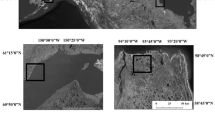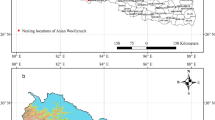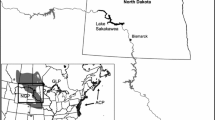Abstract
Urban landscapes present various challenges to semi-aquatic turtle reproduction. In developed regions, golf courses may provide some of the best remaining habitat for turtle populations. We explored nest-site selection of eastern painted turtles (Chrysemys picta) at a golf course pond in Davidson, North Carolina, USA, and modeled nest-site preference using Akaike Information Criterion, with the best supported model favoring nests surrounded by mulch and mowed grass. Additionally, we evaluated nest depredation rates using simulated turtle nests and found that golf course ponds did not have significantly greater nest depredation compared to urban and rural ponds. Our results suggest that golf courses may offer suitable habitat for turtle reproduction in developed areas.

Similar content being viewed by others
References
Akaike H (1973) Information theory and an extension of the maximum likelihood principle. In: Petrov BN, Czaki F (eds) 2nd International Symposium on Information Theory. Akademiai Kiado, Budapest, pp 267–281
Baldwin EA, Marchand MN, Litvaitis JA (2004) Terrestrial habitat use by nesting painted turtles in landscapes with different levels of fragmentation. Northeast Nat 11:41–48
Burke RL, Schneider CM, Dolinger MT (2005) Cues used by raccoons to find turtle nests: effects of flags, human scent, and diamond-backed terrapin sign. J Herpetol 39:312–315
Burnham KP, Anderson DR (1998) Model selection and inference: a practical information-theoretic approach. Springer Verlag, New York
Cagle KD, Packard GC, Miller K, Packard MJ (1993) Effects of the microclimate in natural nests on development of embryonic painted turtles, Chrysemys picta. Funct Ecol 7:653–660
Christens E, Bider JR (1987) Nesting activity and hatching success of the painted turtle (Chrysemys picta marginata) in southwestern Quebec. Herpetologica 43:55–65
Colding J, Lundberg J, Lundberg S, Andersson E (2009) Golf courses and wetland fauna. Ecol Appl 19:1481–1491
Collingham YC, Huntley B (2000) Impacts of habitat fragmentation and patch size upon migration rates. Ecol Appl 10:131–144
Congdon JD, Gatten RE (1989) Movements and energetics of nesting Chrysemys picta. Herpetologica 45:94–100
Conner CA, Douthitt BA, Ryan TJ (2005) Ecology of a turtle assemblage in an urban landscape. Am Midl Nat 153:428–435
Dickman CR (1987) Habitat fragmentation and vertebrate species richness in an urban environment. J Appl Ecol 24:337–351
Doak DF, Marino PC, Kareiva PM (1992) Spatial scale mediates the influence of habitat fragmentation on dispersal success: implications for conservation. Theor Popul Biol 41:315–336
Donovan TM, Hines J (2007) Exercises in occupancy modeling and estimation http://www.uvm.edu/envnr/vtcfwru/spreadsheets/occupancy/occupancy.htm. Accessed 31 August 2011
Ernst CH (1971) Population dynamics and activity cycles of Chrysemys picta in Southeastern Pennsylvania. J Herpetol 5:141–160
Ernst CH, Lovich JE (2009) Turtles of the United States and Canada, 2nd edn. John Hopkins University Press, Baltimore
Failey EL, McCoy JC, Price SJ, Dorcas ME (2007) Ecology of turtles inhabiting golf course and farm ponds in the Western Piedmont of North Carolina. J N C Acad Sci 123:221–232
Gering JC, Blair RB (1999) Predation on artificial bird nests along an urban gradient: predatory risk or relaxation in urban environments? Ecography 22:532–541
Gibbons JW, Greene JL (1990) Chapter 9: reproduction in the slider and other species of turtles. In: Whitfield Gibbons J (ed) Life history and ecology of the slider turtle. Smithsonian Institution Press, Washington, pp 124–134
Gibbs JP, Shriver WG (2002) Estimating the effects of road mortality on turtle populations. Conserv Biol 16:1647–1652
Gibbs JP, Steen DA (2005) Trends in sex ratios of turtles in the United States: implications of road mortality. Conserv Biol 19:552–556
Grayson KL, Dorcas ME (2004) Seasonal temperature variation in the painted turtle (Chrysemys picta). Herpetologica 60:325–336
Harden LA, Price SJ, Dorcas ME (2009) Terrestrial activity and habitat selection of Eastern mud turtles (Kinosternon subrubrum) in a fragmented landscape: implications for habitat management of golf courses and other suburban environments. Copeia 1:78–84
Haxton T (2000) Road mortality of snapping turtles, Chelydra serpentina, in Central Ontario during their nesting period. Can Field Nat 114:106–110
Janzen FJ (1994) Vegetational cover predicts the sex ratio of hatchling turtles in natural nests. Ecology 75:1593–1599
Kareiva PM (1987) Habitat fragmentation and the stability of predator–prey interactions. Nature 326:388–390
Kolbe JJ, Janzen FJ (2002) Impact of nest-site selection on nest success and nest temperature in natural and disturbed habitats. Ecology 83:269–281
Legler JM (1954) Nesting habits of the western painted turtle, Chrysemys picta bellii. Herpetologica 10:137–144
Lindsay SD, Dorcas ME (2001) Effects of cattle on reproduction and morphology of pond dwelling turtles in North Carolina. J Elisha Mitchell Sci Soc 117:249–257
Marchand MN, Litvaitis JA (2004) Effects of habitat features and landscape composition on the population structure of a common aquatic turtle in a region undergoing rapid development. Conserv Biol 18:758–767
Marchand MN, Litvaitis JA, Maier TJ, DeGraaf RM (2002) Use of artificial nests to investigate predation on freshwater turtle nests. Wildl Soc Bull 30:1092–1098
McKinney ML (2002) Urbanization, biodiversity, and conservation. BioScience 52:883–890
Mitchell JC (1988) Population ecology and life histories of the freshwater turtles Chrysemys picta and Sternotherus odoratus in an urban lake. Herpetol Monogr 2:40–61
Nour N, Matthysen E, Dhondt AA (1993) Artificial nest predation and habitat fragmentation: different trends in bird and mammal predators. Ecography 16:111–116
Prange S, Gehrt SD, Wiggers EP (2004) Influences of anthropogenic resources on raccoon (Procyon lotor) movements and spatial distribution. J Mammal 85:483–490
Ramakrishna A, Tam HM, Wani SP, Long TD (2006) Effect of mulch on soil temperature, moisture, weed infestation and yield of groundnut in northern Vietnam. Field Crops Res 95:115–125
Rodewald PG, Santiago MJ, Rodewald AD (2005) Habitat use of breeding red-headed woodpeckers on golf courses in Ohio. Wildl Soc Bull 33:448–453
Rowe JW, Clark DL, Porter M (2005) Nest placement, nest-site fidelity and nesting movements in midland painted turtles (Chrysemys picta marginata) on Beaver Island, Michigan. Am Midl Nat 154:383–397
Ryan TJ, Conner CA, Douthitt BA, Sterrett SC, Salsbury CM (2008) Movement and habitat use of two aquatic turtles (Graptemys geographica and Trachemys scripta) in an urban landscape. Urban Ecosyst 11:213–225
Schwarzkopf L, Brooks RJ (1987) Nest-site selection and offspring sex ratio in painted turtles, Chrysemys picta. Copeia 1987:53–61
Shepard DB, Kuhns AR, Dreslik MJ, Phillips CA (2008) Roads as barriers to animal movement in fragmented landscapes. Anim Conserv 11:288–296
Steen DA, Gibbs JP (2004) Effects of roads on the structure of freshwater turtle populations. Conserv Biol 18:1143–1148
Strickland J, Colbert P, Janzen FJ (2010) Experimental analysis of effects of markers and habitat structure on predation of turtle nests. J Herpetol 44:467–470
Tinkle DW, Congdon JD, Rosen PC (1981) Nesting frequency and success: implications for the demography of painted turtles. Ecology 62:1426–1432
Trauth SE, Robison HW, Plummer MV (2004) The amphibians and reptiles of Arkansas. University Arkansas Press, Fayetteville
Tuberville TD, Burke VJ (1994) Do flag markers attract turtle nest predators? J Herpetol 28:514–516
White GC, Burnham KP (1999) Program MARK: survival estimation from populations of marked animals. Bird Study 46(Supplement):120–138
Wilcove DS (1985) Nest predation in forest tracts and the decline of migratory songbirds. Ecology 66:1211–1214
Wilhoft DC, Del Baglivo MG, Del Baglivo MD (1979) Observations on mammalian predation of snapping turtle nests (reptilia, testudines, chelydridae). J Herpetol 13:435–438
Acknowledgments
Special thanks to L. Witczak, C. Williams, E. Eskew, and S. Hunt for their assistance with this project. The authors thank all of the participating landowners for the use of their property during this project and Dennis Testerman for assistance with locating suitable ponds. Funding for this project was provided by Davidson College Biology Department, Duke Power, the Duke Endowment through the Davidson Research Initiative, and the National Fish and Wildlife Foundation Wildlife Links Program.
Author information
Authors and Affiliations
Corresponding author
Rights and permissions
About this article
Cite this article
Foley, S.M., Price, S.J. & Dorcas, M.E. Nest-site selection and nest depredation of semi-aquatic turtles on golf courses. Urban Ecosyst 15, 489–497 (2012). https://doi.org/10.1007/s11252-012-0229-4
Published:
Issue Date:
DOI: https://doi.org/10.1007/s11252-012-0229-4




